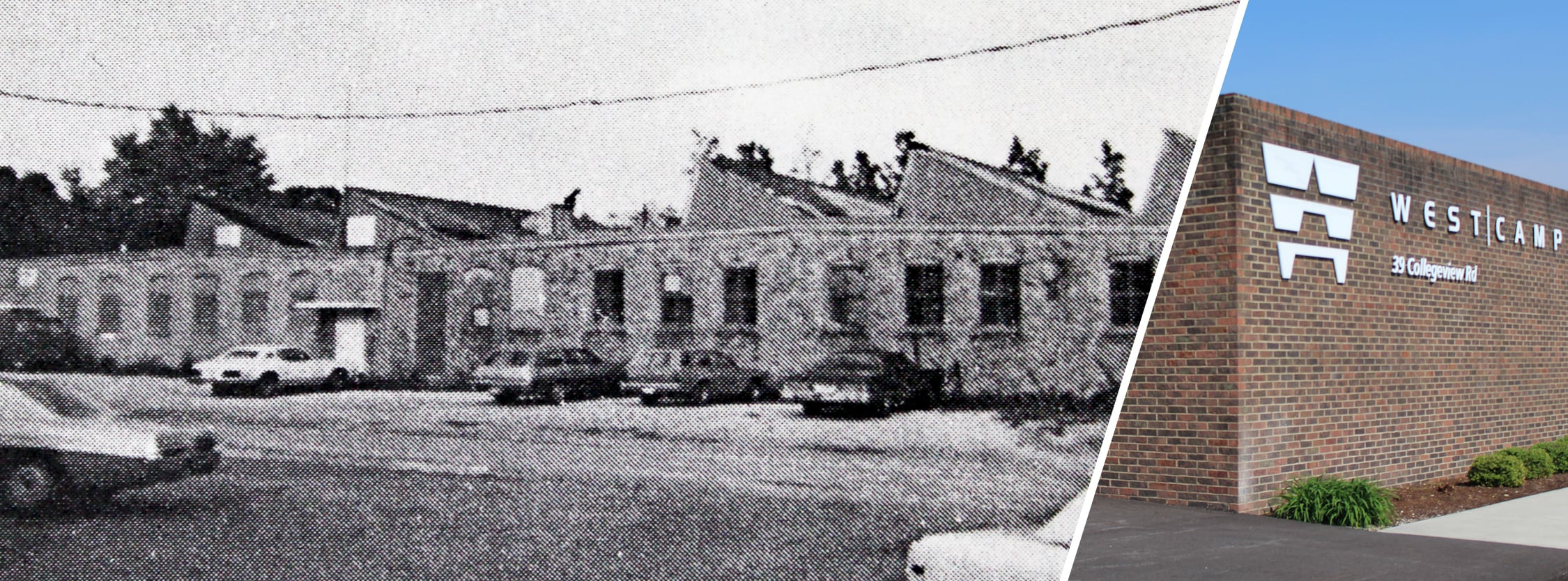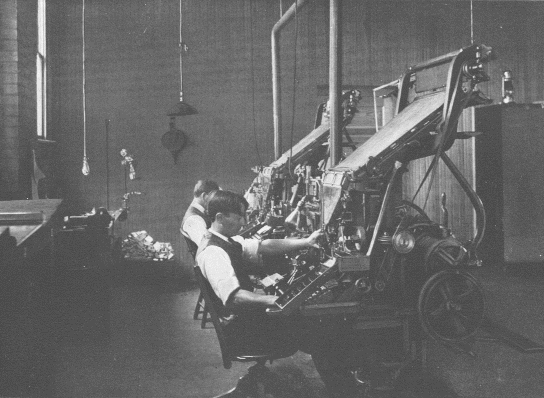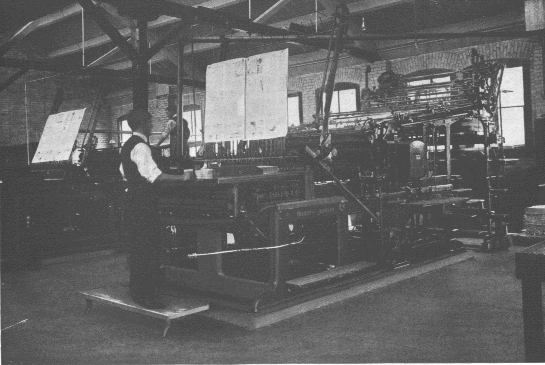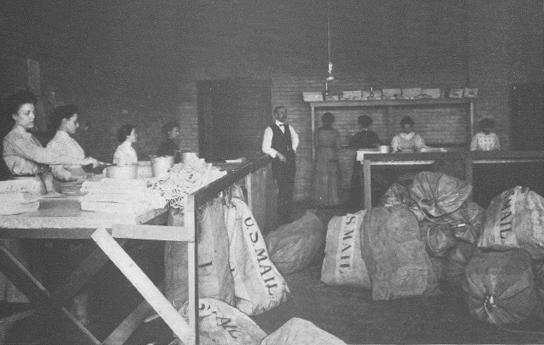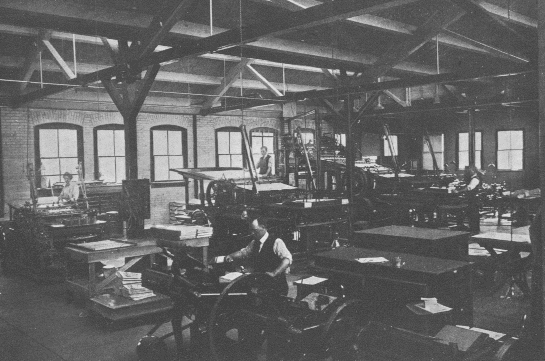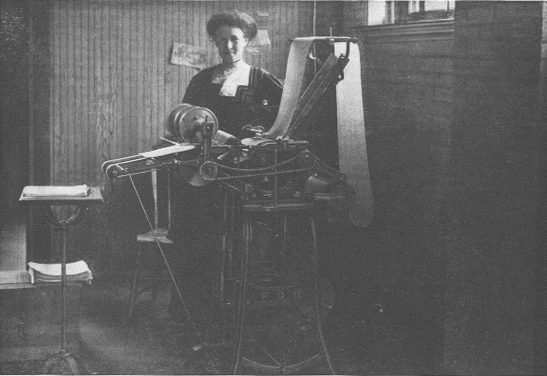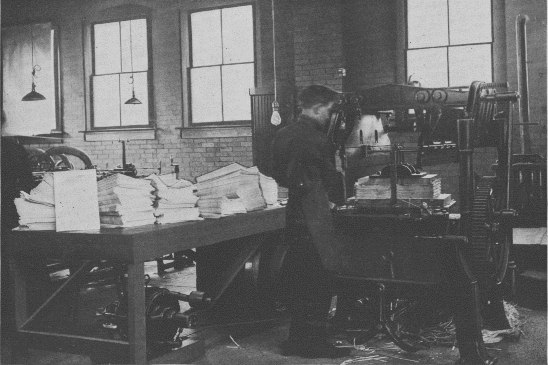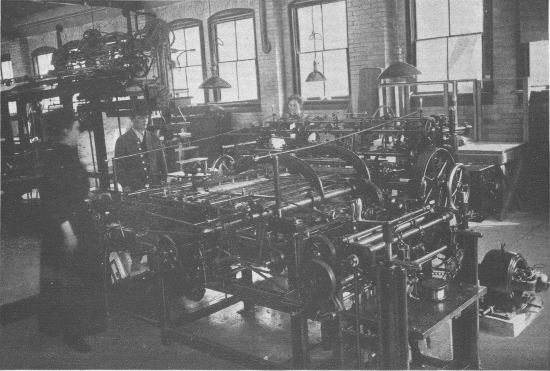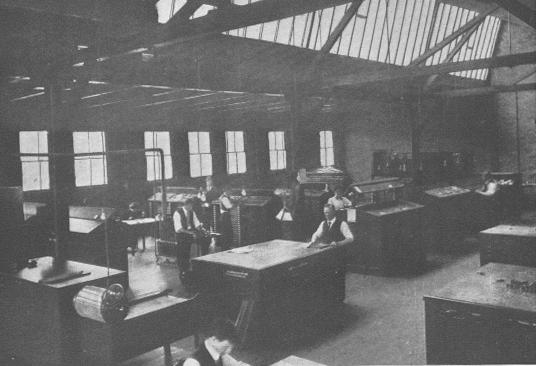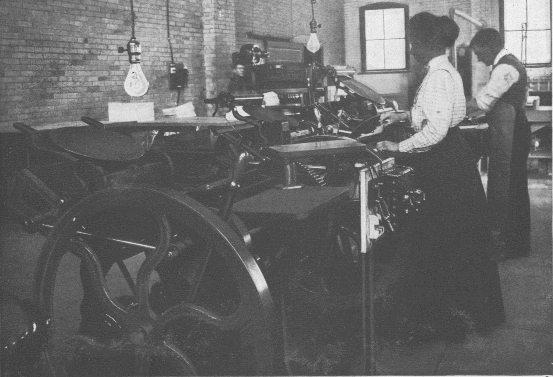WESTCAMP PRESS THROUGH TIME
Quality, Stability and Longevity - Over 100 years of printing history.
The insistent burst of the train whistle pierced the early morning silence as the freight engine lumbered into the station, ready to receive and deliver another shipment of printed materials carefully and efficiently produced by the hardworking employees of Westerville’s American Issue Publishing Company in the early 1900s. Although WestCamp no longer ships by rail in this modern age, our enthusiasm for quality and consistency in our work still matches that of our ancestral company as we continue to build on the longevity and stability established in the past century.
The uniqueness of the WestCamp company name involves much more than perhaps a question of simple geography, of “being west of the Otterbein campus,” as a customer once inquired. While the name, officially adopted in December 1961, is the result of a merger between two old and established central Ohio printing organizations, Westerville Press, Inc. and Clare L. Campbell Inc., the beginnings of our current-day company extend nearly to the turn of the twentieth century and influenced a far greater number of people across the country in its time than merely the small population of the village of Westerville.
As the new town was in its infancy in the mid-1800s, Westerville’s trustees established one of the earliest prohibition ordinances in Ohio, banning the sale of beer, wine, and liquors. This move reflected the early growth of a temperance movement against alcohol in other towns and states across the country, with the formation of the Anti-Saloon League of America occurring in the 1890s as a result, with headquarters in Washington D.C.
Although Westerville’s local law was challenged twice in the 1870s by a persistent, aspiring saloon owner, the opposition was explosive, literally, and Westerville remained known as “the dry capital of the world” following the incidents often known as the “Whiskey Wars.”
The Anti-Saloon League increasingly spread its insistent and persuasive message for the establishment of a “dry,” rather than “wet,” nation to the people of the country through printed materials such as booklets, folders, placards, and The American Issue newspaper, which became the voice of the movement.
As the League’s demands for printing increased, in 1908 the newly formed Westerville Board of Trade raised $7000 to promote Westerville as the new permanent location for the League’s printing department. The village postmaster traveled to Washington D.C. to offer a site in Westerville for the construction of a printing facility, and the village’s early, brave move toward temperance years previous proved fruitful as it was chosen as the new site, in part, no doubt, because Westerville was considered “a village…socially clean and morally upright.”
The American Issue Publishing Company was formed in June 1909 as the parent company of the Anti-Saloon League of America, with national headquarters in Westerville, Ohio. The new plant, a large, saw tooth-roofed building, containing over 10,000 square feet, was dedicated in September 1909 and was located on the site of the current Westerville library parking lot, at 120 S. State St.
Ernest H. Cherrington, considered by many to be the father of the temperance movement, was named editor-in-chief of the company, and soon after, in 1910, named general manager. In charge of all anti-alcohol literature, Cherrington soon saw his plant, in 1915, producing 40 tons of printed material a month and in 1920 The American Issue newspaper reached more than 1.7 million subscribers.
For a time, during the height of the Anti-Saloon League’s push for national prohibition in 1914-1915, employees of the American Issue Publishing Company, the world’s largest prohibition printing facility, ran three shifts a day, 24 hours a day, to produce the “dry literature” that was in such high demand. Some say that freight trains pulled into the Westerville station overflowing with just as many loads of checks and orders for materials as there were printed pieces packed into the train to be shipped out for delivery. Cherrington had indeed built the company into a huge publishing enterprise and possessed a great deal of personal power and influence within the temperance movement.
The large volume of printed materials helped propel the nation to vote the 18th Amendment to the Constitution enforcing Prohibition into law in early 1919. But soon, growing dissension among the League’s leadership and growing opposition to the legal banishment of all alcohol made the Prohibition era short-lived as the Amendment was repealed just a few years later in 1933. Through the years following the Repeal and after World War II, the volume of printing had decreased a great deal, and in 1948 the Anti-Saloon League of America changed its name to the Temperance Education Foundation and made the American Issue Publishing Company a trust of the Foundation.
Shortly after in 1949 the printing plant was sold to A.M. Courtright, owner of the Westerville newspaper The Public Opinion, and it was renamed Westerville Press, Inc. The machinery used for printing at that time was all letterpress equipment, but the changeover to offset printing began in the mid-’50s with the purchase and installation of one offset press. Letterpress was eventually phased out completely in favor of offset printing in the mid-1960s.
The company struggled through some difficult times due in part to old letterpress, bindery, and linotype equipment. Mr. Courtright also had limited contacts within the Columbus printing market, making the company’s attempts to obtain printing jobs a stronger challenge. In spite of that, Westerville Press still claimed a variety of different and important accounts, such as the American Motorcycle Association, the Ohio Pharmaceutical Association, the Railway Tie Association, and the American Issue Publishing Company – which continued to use presses for its printing needs until it ceased publication some years ago.
During this time in the 1950s, a young linotype operator named Glenn Gornall was hired, soon becoming assistant plant manager. Not long after 1961, A.M. Courtright made a move to gain a stronger entrée into the Columbus market as well as to obtain a hands-on management individual. An agreement was reached between Clare L. Campbell and his son, Don, to merge their company, Campbell Printing Inc., with Westerville Press, Inc. The new organization, West-Camp Press, Inc., was incorporated in December 1961.
The first few years of the new company were difficult. The poor condition of the old equipment, low employee morale, and the struggle to break into the Columbus market were all contributing factors. Despite all this, management approved a risky across-the-board pay increase, which soon paid off in improved employee morale as well as increased production quality and quantity.
Clare Campbell’s reputation within the Columbus printing community and his close friendship with Reid Vance, officer in the former Printing Arts Association, began to pay dividends for the new West-Camp Press. Glenn was named plant manager of the company during this time, and Clare, Don, and Glenn all served as officers at various intervals for the Printing Industry of Columbus, formerly the Printing Arts Association, and the Columbus Club of Printing House Craftsmen. These new ties and contacts helped increase business and had been missing factors under the old Westerville Press management. The greatest benefit of these contacts was the help Reid Vance gave to Don Campbell in obtaining the account for several years of The Ohio State University Athletic department in the 1960s for production of the OSU football programs.
In a relatively short time, WestCamp became solid enough to build and lease a new building, greatly increasing production capacity. And in the 1970s Mr. Courtright sold his interest in the company to Don and Glenn. He moved The Public Opinion newspaper office from the WestCamp building in January 1972.
During those growth years, Glenn Gornall obtained more responsibility for the business and eventually arranged with Don Campbell for a long-term purchase of the business, becoming president in 1974. The purchase was completed in 1994 as Don reduced his management responsibility. Since then, Glenn became the sole owner of the successful company, with Don as a consultant and member of the company’s Board.
Seeing the need to expand beyond offset printing, in 1999, WestCamp is the first central Ohio printer to install a significant Digital press.
In 2006, the Company’s Plant Manager, Dave Marsh, and Manager of Sales and Marketing, Ed Evans, buy the Company and fill the roles of President and CEO, respectively. Again, looking to the future, in 2007, WestCamp adds its first Wide Format device. Over the next several years, while remaining strong in Offset printing, the segments of Digital and Wide Format grow well for the Company.
During this same time, the Company develops the business relationship it has with Central Ohio Graphics, Inc. Noting similar cultures and the opportunity for many synergies, in 2011, WestCamp acquires Central Ohio Graphics and adds Chip Hilleary to the ownership and management team.
Aware of the Company’s proud history of being the oldest major supplier of printed matter in central Ohio, the ownership team of Marsh, Evans, and Hilleary looked for the best way to assure the Company’s future, serving its customers, and rewarding the dedicated employees. In 2015, the Company puts a 100% Employee Stock Ownership Plan (ESOP) in place.
WestCamp is unique and special in many ways, from its history, to its offerings, to its service, to the employee-owners managing the future. The train whistle has faded but Westerville and WestCamp thrive. While looking back on our long and proud history, the focus is as strong as ever in providing quality service to WestCamp customers that is responsive, flexible, and best of class. A process that addresses customer concerns and is positive for everyone. WestCamp continually strives to fulfill its goal of developing a system that provides quality, stability, and longevity for its customers, its employee-owners, its vendors, and its community.
Anti-Saloon photos courtesy of the Westerville Public Library.

